Solution (kinda):
Turns out this impersonation with .NET's security only allows application-level access. Since the COM object is at the system level, the impersonated user still cannot instantiate it. I figured this out by right-clicking the executable and selecting "Run As...", the program functioned fine. I found out that launches the program with system access (assuming the user you are running it with has those credentials). Now I am in the process of creating an external program that will launch this application using this method.
Thanks for the tips :D
I have a windows XP installation on a virtual machine. It is part of my domain, but the logged in user is a local user only. Obviously, if I try to access a network share it will prompt for a user/password:
The program I am testing out on the virtual machine uses a COM object to interface with data from another program. If I do not impersonate, I get errors because I do not have the proper credentials.
I did some research into the matter and found a number of websites that had a decent amount of VB.NET information. The problem I am having with the code I wrote is I can access the network resources, but I cannot instantiate the COM object.
If I fill and submit the credential prompt (above) before attempting to instantiate it, it works fine. That leads me to believe there must be something that the WinXP credential prompt is doing that I am not. Below is the code I am using for Impersonation:
Public Sub BeginImpersonation()
Const LOGON32_PROVIDER_DEFAULT As Integer = 0
Const LOGON32_LOGON_INTERACTIVE As Integer = 2
Const SecurityImpersonation As Integer = 2
Dim win32ErrorNumber As Integer
_tokenHandle = IntPtr.Zero
_dupeTokenHandle = IntPtr.Zero
If Not LogonUser(_username, _domainname, _password, LOGON32_LOGON_INTERACTIVE, LOGON32_PROVIDER_DEFAULT, _tokenHandle) Then
win32ErrorNumber = System.Runtime.InteropServices.Marshal.GetLastWin32Error()
Throw New ImpersonationException(win32ErrorNumber, GetErrorMessage(win32ErrorNumber), _username, _domainname)
End If
If Not DuplicateToken(_tokenHandle, SecurityImpersonation, _dupeTokenHandle) Then
win32ErrorNumber = System.Runtime.InteropServices.Marshal.GetLastWin32Error()
CloseHandle(_tokenHandle)
Throw New ImpersonationException(win32ErrorNumber, "Unable to duplicate token!", _username, _domainname)
End If
Dim newId As New System.Security.Principal.WindowsIdentity(_dupeTokenHandle)
_impersonatedUser = newId.Impersonate()
_impersonating = True
End Sub
I have also tried sending different flags to the impersonator method, but nothing seems to be working. Here are the different flags I found:
Enum LOGON32_LOGON
INTERACTIVE = 2
NETWORK = 3
BATCH = 4
SERVICE = 5
UNLOCK = 7
NETWORK_CLEARTEXT = 8
NEW_CREDENTIALS = 9
End Enum
Enum LOGON32_PROVIDER
[DEFAULT] = 0
WINNT35 = 1
WINNT40 = 2
WINNT50 = 3
End Enum
Enum SECURITY_LEVEL
Anonymous = 0
Identification = 1
Impersonation = 2
Delegation = 3
End Enum
